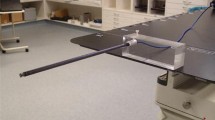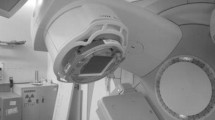Abstract
Measurement of dose distribution in patients during radiotherapy is impossible. The Monte Carlo simulation is an alternative method for dose calculations. In routine radiotherapy, the source-to-surface distance (SSD) method is not practical for an isocentric unit because it requires numerous values of tissue–air ratios and inverse square law. Therefore, this method is time consuming. In this paper, the curves of relative depth doses were obtained for three different SSDs using the MCNP4C Monte Carlo simulation and approximated with a single curve called calibration curve. This curve was compared to the curve obtained by published data, differing in approximately 5% in the worst case. It was also observed that the obtained results were more accurate for distances between −5 and 10 cm from source-to-axis distance.




Similar content being viewed by others
References
F.M. Khan, J.P. Gibbons, Khan’s The Physics of Radiation Therapy (Lippincott Williams & Wilkins, Philadelphia, 2014)
M.J. Tahmasebi Birjani, S.M. Karbalaee, Calculation of analytical expressions for measured percentage depth dose data in megavoltage photon therapy. IRCMJ 11, 140–144 (2009)
M.M.H. Baba, M. Mohib-ul-Haq, M.A.A. Khan, Dosimetric consistency of Co-60 teletherapy unit-a 10 years study. Int. J. Health Sci. 7, 15–21 (2013). doi:10.12816/0006016
G. Audi, O. Bersillon, J. Blachot et al., The NUBASE evaluation of nuclear and decay properties. Nucl. Phys. A 729, 3–128 (2003). doi:10.1016/S0375-9474(97)00482-X
National Research Council (US), Committee on Radiation Source Use and Replacement (Nuclear and Radiation Studies Board, Washington, DC, 2008)
E.B. Podgorsak, Review of Radiation Oncology Physics: A Handbook for Teachers and Students (International Atomic Energy Agency, Vienna, 2003)
H.E. Johns, J.R. Cunningham, The Physics of Radiology (Charles C. Thomas, Springfield, 1983)
J. Van de Geijn, The computation of two and three dimensional dose distributions in Co-60 teletherapy. Br. J. Radiol. 38, 369–377 (1965). doi:10.1259/0007-1285-38-449-369
T. Sterling, H. Perry, J. Weinkam, Automation of radiation treatment planning—VI. A general field equation to calculate percent depth dose in the irradiated volume of a cobalt 60 beam. Br. J. Radiol. 40, 463–474 (1967). doi:10.1259/0007-1285-40-474-463
C. Kanellitsas, J.V. Fayos, Analytical approach for depth dose calculations (60Co beams with fixed source-target distance). Radiology 115(1), 181–185 (1975). doi:10.1148/115.1.181
I.A. Tsalafoutas, S. Xenofos, A. Papalexopoulous et al., Dose calculations for asymmetric fields defined by independent collimators using symmetric field data. Br. J. Radiol. 73, 403–409 (2000). doi:10.1259/bjr.73.868.10844866
M. Ghorbani, M.J. Tahmasebi Birjani, A. Mehdizade, New formula for calculation of cobalt 60 percentage depth dose. IJMP 2, 53–60 (2005)
K. Han, D. Ballon, C. Chui et al., Monte Carlo simulation of a cobalt-60 beam. Med. Phys. 14, 414–419 (1987). doi:10.1118/1.596120
G.M. Mora, A. Maio, D.W.O. Rogers, Monte Carlo simulation of a typical 60Co therapy source. Med. Phys. 26, 2494–2502 (1999). doi:10.1118/1.598770
B.T. Sichani, M. Sohrabpour, Monte Carlo dose calculations for radiotherapy machines: Theratron 780-C teletherapy case study. Phys. Med. Biol. 49, 807 (2004). doi:10.1088/0031-9155/49/5/011
R. Miro, J. Soler, S. Gallardo et al., MCNP simulation of a Theratron 780 radiotherapy unit. Radiat. Prot. Dosim. 116, 65 (2005). doi:10.1093/rpd/nci125
W.S. Jae, H. Seung-Woo, L. Chung-Il et al., Application of a GEANT4 Simulation to a 60Co Therapy Unit. J. Korean Phys. Soc. 59(1), 12–19 (2011). doi:10.3938/jkps.59.12
A.L. McKenzie, Cobalt-60 gamma-ray beams. Br. J. Radiol. 25, 46–61 (1996)
J.K. Shultis, R.E. Faw, An MCNP primer. (Kansas State University, Manhattan), http://www.bl831.als.lbl.gov/~mcfuser/publications/MCNP/MCNP_primer.pdf.2010
International Commission on Radiation Units and measurements (ICRU), Prescribing, Recording and Reporting Photon Beam Therapy (International Commission on Radiation Units and measurements, Bethesda, MD, 1993)
Author information
Authors and Affiliations
Corresponding author
Rights and permissions
About this article
Cite this article
Vahabi, S.M., Shamsaie-Zafarghandi, M. Establishment of a calibration curve for an isocentric cobalt unit using Monte Carlo simulation. NUCL SCI TECH 28, 125 (2017). https://doi.org/10.1007/s41365-017-0275-y
Received:
Revised:
Accepted:
Published:
DOI: https://doi.org/10.1007/s41365-017-0275-y




